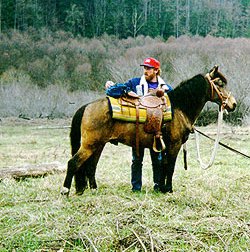
The Galiceņo is usually used as a child's pony due to its small size, although the Galiceņo is well able to carry a man all day in rough country.
Galiceņos are extremely gentle in nature and easy to handle. With such good disposition they are an excellent family horse. From the time of the conquistadors the Galiceņo has performed conceivable tasks and has accomplished each with a remarkable native intelligence. The Galiceņo is bright, alert, and very quick to learn. It shows its worth to the novice and expert alike.
Although the Galiceņo is small, it possesses hardness, courage, and stamina that are difficult for many larger horses to match. Its gaits are smooth and not tiring to the rider. The Galiceņo makes a good cutting horse being agile and fast. It is also excellent in reining classes or timed events.
Setting it apart from pony breeds, this breed possesses substance, style beauty and a natural ground-covering running-walk. All solid colors are accepted for registration while albinos or pintos are not allowed. The head shows refinement with good width between the eyes, pointed ears, a large, lively eye, and a small muzzle; the neck is slightly arched with a clean throat latch and fits smoothly into the withers, which are prominent. The body is smoothly muscled; the back short and straight; the croup slightly sloped with a moderately high tail-set. The hind quarters are set slightly more under the body than other breeds; the joints are strong and well shaped; the shoulder is well sloped, giving a long stride; the forelegs have well muscled forearms. Open at the heel, the feet are well shaped and hard.